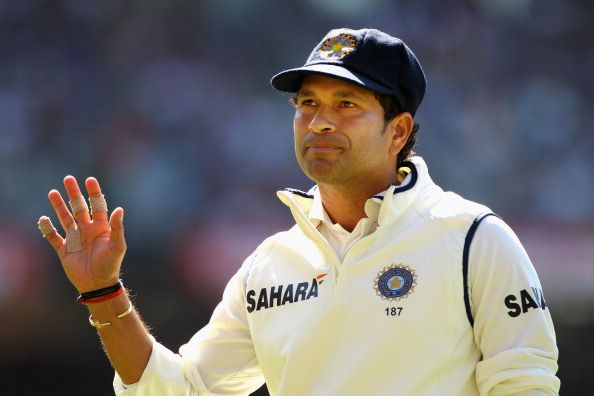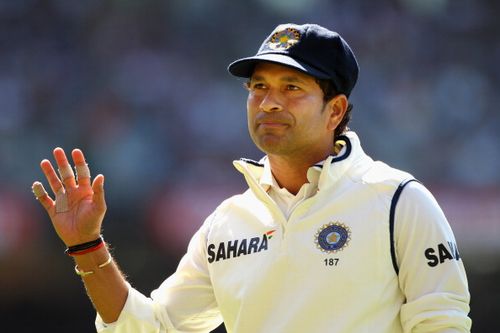
Sachin Tendulkar - what the numbers hide

Sachin Tendulkar
In India, with the rise of social media, everyone has a say over everything, however trivial or vital the issue might be. Being the world’s oldest democracy and given the emphatic success of it in this country, social media has transcended one important clause of this democracy- the right to expression.
Social media is a great platform to express one’s thoughts, yet it has its flip side. The young lot, devoid of sound cricketing opinion, is easily swayed by the rubbish found online that often stems from people with shallow knowledge of the game. Of course everyone is entitled to their opinion, but negative propaganda could prove perilous for the young lot.
In one such occurrence, I found a status update on FB condoning the hype created around the master’s retirement and the frenzied emotions around. Tendulkar to him was just another cricketer and he deserved no bit of this grandeur farewell on the cards. The very concept of a farewell Test was despised.
To my disgruntlement, such writers often turn oblivious to the Indian cricket culture and the mind frame of the people in this nation, the rich heritage and the nasty political mishaps. Pragmatism might be tempting, yet, everything against the herd isn’t pragmatism, it can at times be nothing but preposterous.
The argument here isn’t about Tendulkar deserving a farewell Test or not, the farewell Test is under way. Delving deep into this, the question here is, why does Tendulkar alone in this country enjoy such clout? Who is he really and does he deserve the glitz? One cannot resort to numbers to answer these questions, for the numbers obscure the real Tendulkar. Remember, no one is a Tendulkar fan just for his sheer numbers. There is something more that drives them/us crazy.
At the age of 19, whacking the world’s deadliest pace bowlers is something that I can hardly believe even today. At WACA 1992, when Tendulkar was barely 19, he had the most feared pacers bowl to him in the fastest wicket at the world. The pacers were in no mood to sympathize with this young lad and unleashed a barrage of short pitch deliveries, often aimed at his nose. However, this boy too was in no mood to sympathize- he cut and pulled the short balls ferociously, like a bloody thirsty warrior.
Hitherto, this knock remains to be an user manual of sorts for tackling or rather punishing short pitched bowling. This was around the same time when TV emerged in India, a hero had knocked the doors of every household of this nation.
In the 1990s, the Indian team was far from a formidable unit and the lynch pin of the team was Tendulkar. When every batsman succumbed and submitted, this man stood tall, in stature, and offered resistance, something that was foreign to Indian cricket. Usually at the receiving end, this batsman was a nightmare for the world’s best bowlers.
The Indian fans, often used to opposition batsmen clobbering the Indian bowlers, were now in store for a treat, a retaliation of sorts. The most celebrated bowlers in the world were reduced to dust by his batting prowess and the way he dismantled every bowling attack was certainly a delight to watch. The Indians were in awe, captivated by this batsman’s ability. Battered and bruised for years, Tendulkar was their only form of retaliation, revenge or even retribution. They had found a hero, a lone warrior. With the other batsman falling like nine pins, Tendulkar’s heroics were accentuated.
In 1999 at Chennai, India were in pursuit of big total and it was the fourth innings of the game. Saqlain Mushtaq was at his befuddling best. With most part of the Indian batting line up back in the hut, the mantle was on Tendulkar to manoeuvre the chase. Tendulkar had come into the game with a back injury which had got worse during the course of the match. He was in acute pain as he came into bat two down.
Tendulkar’s mental toughness is what made him stand apart and that mental toughness was in display during this innings. Unfazed by the backache, Tendulkar unveiled a flurry of shots, pulling Mustaq voraciously. Just when the title looked reachable, Tendulkar got out, a result of the pain that had peaked. With less than thirty runs to get and five wickets in hand, India lost the game.
For the fans, it was straight out of a Bollywood film. The hero in pain, yet fights for the nation. Only the climax here differed, but Tendulkar was the hero and more importantly, he was their lone hero.
In India, it was the 90s when viewership rates surged and cricket picked up. Apart from Tendulkar, there wasn’t another source of encouragement and it was this man who attracted a million viewers. This was the time when fans turned to fanatics. This was the time when schoolchildren slipped a transistor into their bags to listen to the score at school. This was around this time people flocked the electronic showrooms and lined up in front of the TV. This was around this time when people shrugged work and were back home early to watch cricket. This was around this time when students flunked exams to watch him bat, this was around this time when this nation replete with differences in everything united in stadiums rooting for this man.
In the 90s, Tendulkar was the hero, the only hero, their new found hero. Advertisers toiled to get Tendulkar’s call sheet, as once contracted the product sales would be catapulted. Boost is a point in case. He was the dream child of every mother and every father, given his conduct on and off the field, any product advertised through him shall reap record sales. Another interesting anecdote, in a Test series which Tendulkar had to miss owing to an injury, the ticket sales were dismal. On the eve of a test match, Tendulkar surprised his fans by confirming his availability for the next Test. That morning, thousands of people had flocked to the stadium and within hours the tickets were sold out. Tendulkar for sure wasn’t a mortal in this nation.
People from India are known for their sentimentality. Right from their epics hero worship was inherent and the hero was glorified to the maximum extent. It permeated throughout the system and it became a part of the Indian culture. Another interesting aspect here is that, Indians seldom lay their belief on something, yet if they do, it would be an Herculean task to erase it.
A group of sentimentally attached and emotionally clustered people. Film actors in this country, just for their sheer heroism were voted as the Chief Minister. Tendulkar was no exception. His heroics were evident, his fortitude, his diligence, his talent were all manifested through the television and Sachin shot to stardom.
India’s history is rife with such stories of stardom and Indian culture isn’t foreign to it. The fulcrum of this nation is its innate bonding and love. Tendulkar was the childhood love for a billion in this nation. This nation has its highest population under the age bracket of 27-35. These people grew up watching Sachin.
Watching would be an understatement, they grew up idolizing Sachin. He was their childhood hero, he formed the most memorable part of their childhood. He was the one who forced them to carry their bats to the roads, he was the reason for their smile, he was the reason for their sorrow, he was the reason behind cricket being an integral part of this nation, he was their own hero, their first hero and their last hero. They grew up, they moved on with life, yet every time he flashed on the TV, they stood still and watched him with the same enthusiasm, as he walked in with equal enthusiasm.
Denying Tendulkar a farewell Test would do no harm to Tendulkar as he’s always remained above such formalities. Yet, it would be grossly unfair for the billions for whom Tendulkar formed the livelihoods. Tendulkar isn’t a separate entity, he is constituted by a billion emotions. This is Tendulkar, a complex, inexplicable being.
Men may come and men may go, he would go on forever.